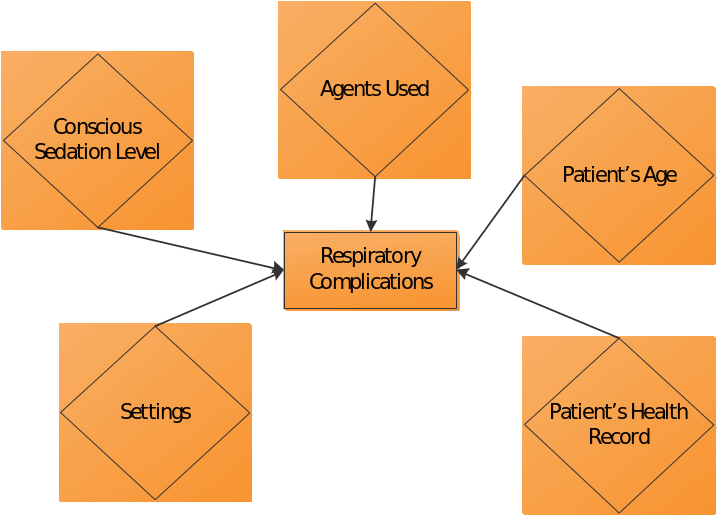Even though conscious sedation is considered to be the safest type of sedation, it might still imply severe respiratory complications (Blayney, 2012). To perform an effective intervention targeted to prevent these complications, it is essential to consider all the key factors that might further affect its course. The paper at hand describes the external factors that are assumed to be critical in the context of planning an intervention for patients undergoing interventional radiological procedures under conscious sedation. The preliminary analysis of the relevant literature has helped to distinguish five factors that modern researchers recognize as vital:

As it might be seen on the conceptual map provided above, the factors that will affect the intervention are patients’ age, health record, settings, the user agents, and the level of conscious sedation.
The first factor is the level of sedation impact. Thus, research shows that those patients that experience the severe impact of sedation are more exposed to potential respiratory complications. According to Johnson (2011), this external factor should be essentially considered while planning out the relevant preventative interventions. As a result, the level of sedation will help to target the intervention population – patients undergoing high-level sedation will receive a special priority as they compose a risk group.
The second factor that is supposed to affect the planned intervention is the agents that are used in the course of conscious sedation: opioids, propofol, ketamine, etc. Research shows that those patients that receive propofol dozes are more exposed to experiencing respiratory complications that those that receive ketamine, for example (Tobias & Leder, 2011). Therefore, this factor will likewise hurt the planned intervention.
Another critical factor that will naturally affect the planned intervention is the patient’s age. It is considered to account for the age peculiarities of the patients to foresee potential challenges (Triantafillidis, Merikas, Nikolakis, & Papalois, 2012). Hence, for instance, Tobias and Leder (2011) point out that according to their study, small children aged three months old and less are more exposed to the risks of respiratory complications than others. Among the complications associated with this age group, the authors put a particular emphasis on laryngeal excitability as well as airway anatomy. As a result, the age factor will affect the planned intervention considerably.
Additionally, such a factor as the patient’s previous health record will likewise influence the planned intervention. Thus, numerous studies provide evidence of a close interconnection between the patient’s medical records and the potential respiratory complications they might face in the course of the interventional radiological procedures under conscious sedation. Hence, for example, Amornyotin (2013) notes that a careful examination of the drug history might prevent the undesirable reaction to a particular agent that can further provoke severe respiratory complications.
Finally, the planned intervention will be essentially affected by such factors as settings. This external factor plays an important role as it determines both the intervention limitations and the psychological state of a patient. Research shows that unfavorable settings for radiology sedation are more likely to cause anxiety and claustrophobia that, in their turn, lead to the respiratory distortion (Blayney, 2012). As a consequence, the setting factor is expected to affect the planned intervention.
The provided list of the impact factors is not complete; meanwhile, it comprises the most critical aspects that are expected to have an impact on the planned intervention. These factors are most commonly referred to in research associated with patients undergoing interventional radiological procedures under conscious sedation.
Reference List
Amornyotin, S. (2013). Sedation-related complications in gastrointestinal endoscopy. World Journal of Gastrointestinal Endoscopy, 5(11), 527-533.
Blayney, M. R. (2012). Sedation-related complications in gastrointestinal endoscopy. Continuing Education in Anesthesia, Critical Care & Pain, 12(4), 176-180.
Johnson, S. (2011). Sedation and Analgesia in the Performance of Interventional Procedures. Seminars in Interventional Radiology, 27(4), 368-373.
Tobias, J. D., & Leder, M. (2011). Procedural sedation: A review of sedative agents, monitoring, and management of complications. Saudi Journal of Anesthesia, 5(4), 395-410.
Triantafillidis, J. K., Merikas, E., Nikolakis, D., & Papalois, A. E. (2012). Sedation in gastrointestinal endoscopy: Current issues. World Journal of Gastroenterology, 19(4), 463- 481.